Acute Health Problems and Nursing Care: Diploma of Nursing Assignment
VerifiedAdded on 2023/05/30
|26
|7041
|91
Homework Assignment
AI Summary
This comprehensive nursing assignment addresses various acute health problems, including renal disorders, gastrointestinal issues, neurological disorders, and respiratory problems, detailing their signs, symptoms, and causes. It also explores surgical nursing principles, explaining procedures such as elective/emergency surgeries, anesthetics, amputations, hip replacements, and craniotomies. The assignment further examines holistic care approaches in acute settings, nursing interventions, and outcomes. It covers potential and actual health issues related to total hip replacement and provides detailed information on intravenous fluid intake, central venous catheters, total parental nutrition, and nasogastric tube feeds, including their purposes, complications, and nursing management. Pre- and post-operative management of appendectomy patients, PICC line indications, complications, and nursing management, and strategies for managing post-operative pain are also included. The assignment provides a thorough overview of essential nursing practices and patient care in acute healthcare environments.
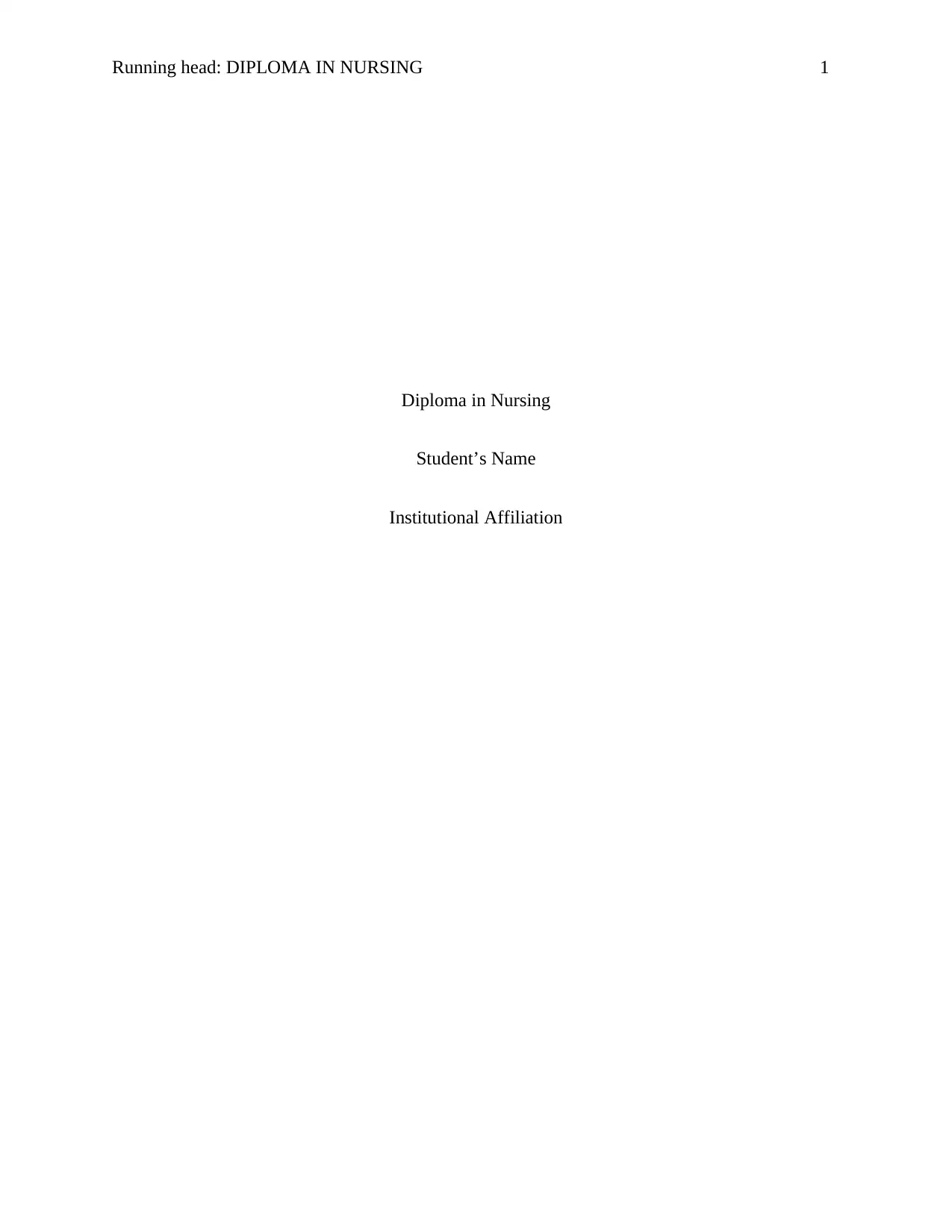
Running head: DIPLOMA IN NURSING 1
Diploma in Nursing
Student’s Name
Institutional Affiliation
Diploma in Nursing
Student’s Name
Institutional Affiliation
Paraphrase This Document
Need a fresh take? Get an instant paraphrase of this document with our AI Paraphraser
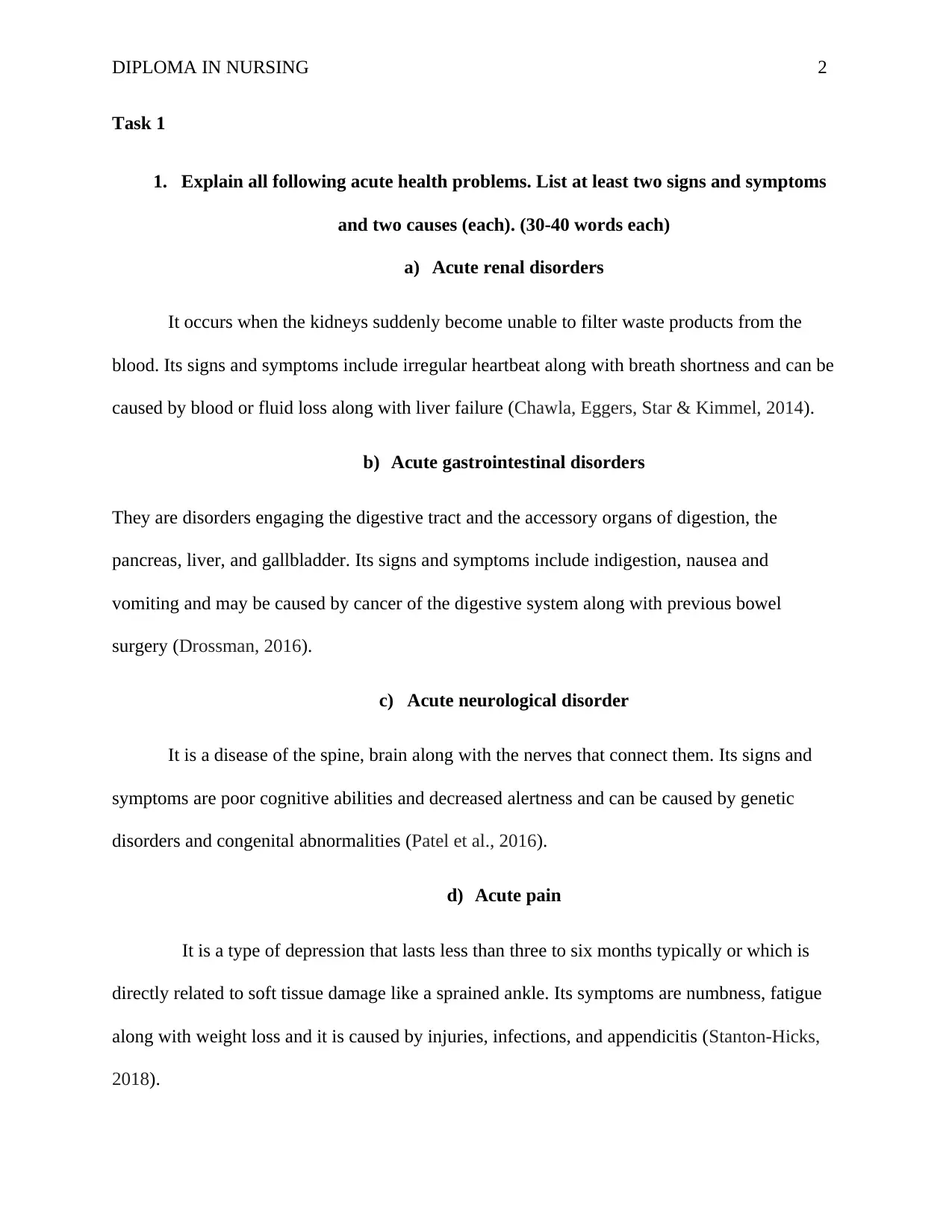
DIPLOMA IN NURSING 2
Task 1
1. Explain all following acute health problems. List at least two signs and symptoms
and two causes (each). (30-40 words each)
a) Acute renal disorders
It occurs when the kidneys suddenly become unable to filter waste products from the
blood. Its signs and symptoms include irregular heartbeat along with breath shortness and can be
caused by blood or fluid loss along with liver failure (Chawla, Eggers, Star & Kimmel, 2014).
b) Acute gastrointestinal disorders
They are disorders engaging the digestive tract and the accessory organs of digestion, the
pancreas, liver, and gallbladder. Its signs and symptoms include indigestion, nausea and
vomiting and may be caused by cancer of the digestive system along with previous bowel
surgery (Drossman, 2016).
c) Acute neurological disorder
It is a disease of the spine, brain along with the nerves that connect them. Its signs and
symptoms are poor cognitive abilities and decreased alertness and can be caused by genetic
disorders and congenital abnormalities (Patel et al., 2016).
d) Acute pain
It is a type of depression that lasts less than three to six months typically or which is
directly related to soft tissue damage like a sprained ankle. Its symptoms are numbness, fatigue
along with weight loss and it is caused by injuries, infections, and appendicitis (Stanton-Hicks,
2018).
Task 1
1. Explain all following acute health problems. List at least two signs and symptoms
and two causes (each). (30-40 words each)
a) Acute renal disorders
It occurs when the kidneys suddenly become unable to filter waste products from the
blood. Its signs and symptoms include irregular heartbeat along with breath shortness and can be
caused by blood or fluid loss along with liver failure (Chawla, Eggers, Star & Kimmel, 2014).
b) Acute gastrointestinal disorders
They are disorders engaging the digestive tract and the accessory organs of digestion, the
pancreas, liver, and gallbladder. Its signs and symptoms include indigestion, nausea and
vomiting and may be caused by cancer of the digestive system along with previous bowel
surgery (Drossman, 2016).
c) Acute neurological disorder
It is a disease of the spine, brain along with the nerves that connect them. Its signs and
symptoms are poor cognitive abilities and decreased alertness and can be caused by genetic
disorders and congenital abnormalities (Patel et al., 2016).
d) Acute pain
It is a type of depression that lasts less than three to six months typically or which is
directly related to soft tissue damage like a sprained ankle. Its symptoms are numbness, fatigue
along with weight loss and it is caused by injuries, infections, and appendicitis (Stanton-Hicks,
2018).
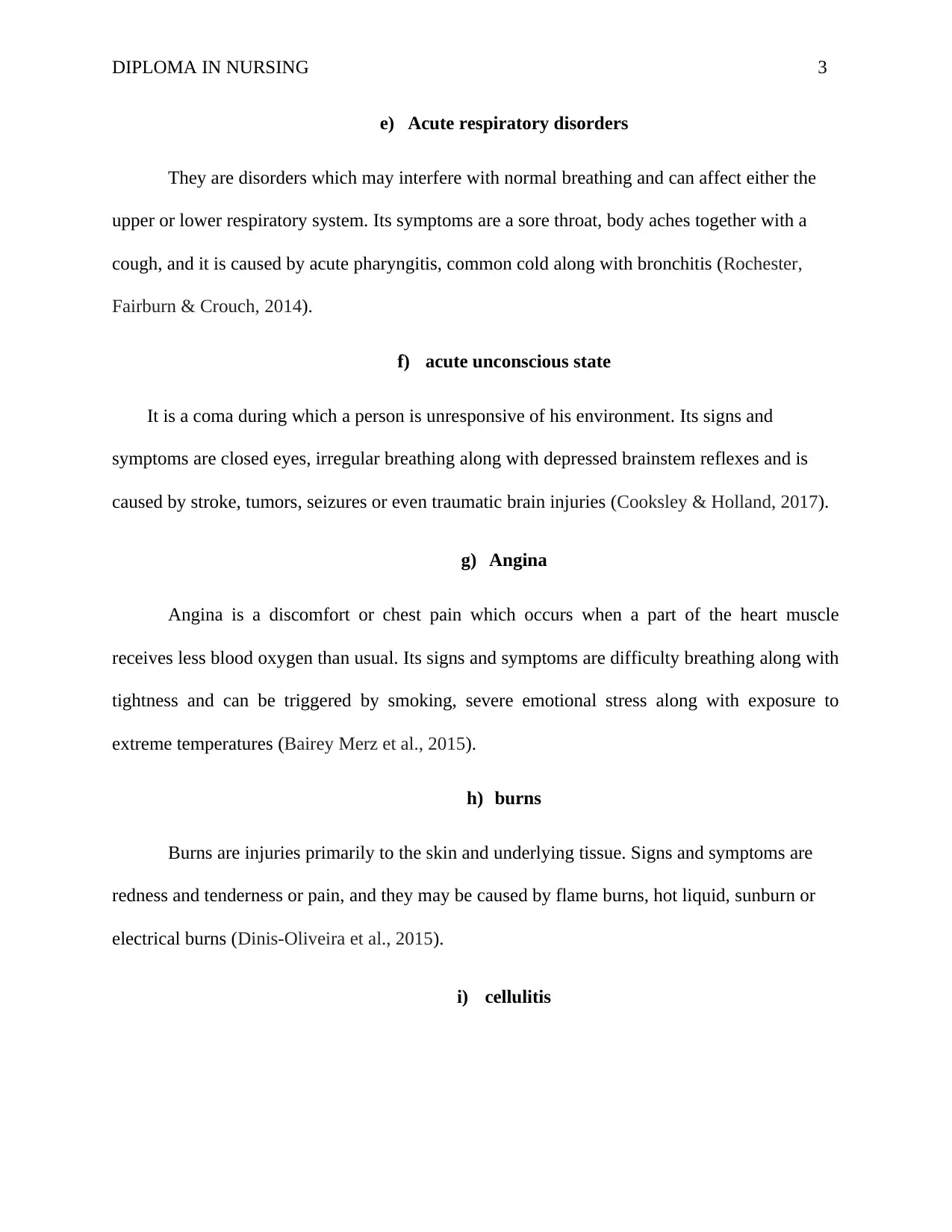
DIPLOMA IN NURSING 3
e) Acute respiratory disorders
They are disorders which may interfere with normal breathing and can affect either the
upper or lower respiratory system. Its symptoms are a sore throat, body aches together with a
cough, and it is caused by acute pharyngitis, common cold along with bronchitis (Rochester,
Fairburn & Crouch, 2014).
f) acute unconscious state
It is a coma during which a person is unresponsive of his environment. Its signs and
symptoms are closed eyes, irregular breathing along with depressed brainstem reflexes and is
caused by stroke, tumors, seizures or even traumatic brain injuries (Cooksley & Holland, 2017).
g) Angina
Angina is a discomfort or chest pain which occurs when a part of the heart muscle
receives less blood oxygen than usual. Its signs and symptoms are difficulty breathing along with
tightness and can be triggered by smoking, severe emotional stress along with exposure to
extreme temperatures (Bairey Merz et al., 2015).
h) burns
Burns are injuries primarily to the skin and underlying tissue. Signs and symptoms are
redness and tenderness or pain, and they may be caused by flame burns, hot liquid, sunburn or
electrical burns (Dinis-Oliveira et al., 2015).
i) cellulitis
e) Acute respiratory disorders
They are disorders which may interfere with normal breathing and can affect either the
upper or lower respiratory system. Its symptoms are a sore throat, body aches together with a
cough, and it is caused by acute pharyngitis, common cold along with bronchitis (Rochester,
Fairburn & Crouch, 2014).
f) acute unconscious state
It is a coma during which a person is unresponsive of his environment. Its signs and
symptoms are closed eyes, irregular breathing along with depressed brainstem reflexes and is
caused by stroke, tumors, seizures or even traumatic brain injuries (Cooksley & Holland, 2017).
g) Angina
Angina is a discomfort or chest pain which occurs when a part of the heart muscle
receives less blood oxygen than usual. Its signs and symptoms are difficulty breathing along with
tightness and can be triggered by smoking, severe emotional stress along with exposure to
extreme temperatures (Bairey Merz et al., 2015).
h) burns
Burns are injuries primarily to the skin and underlying tissue. Signs and symptoms are
redness and tenderness or pain, and they may be caused by flame burns, hot liquid, sunburn or
electrical burns (Dinis-Oliveira et al., 2015).
i) cellulitis
⊘ This is a preview!⊘
Do you want full access?
Subscribe today to unlock all pages.

Trusted by 1+ million students worldwide
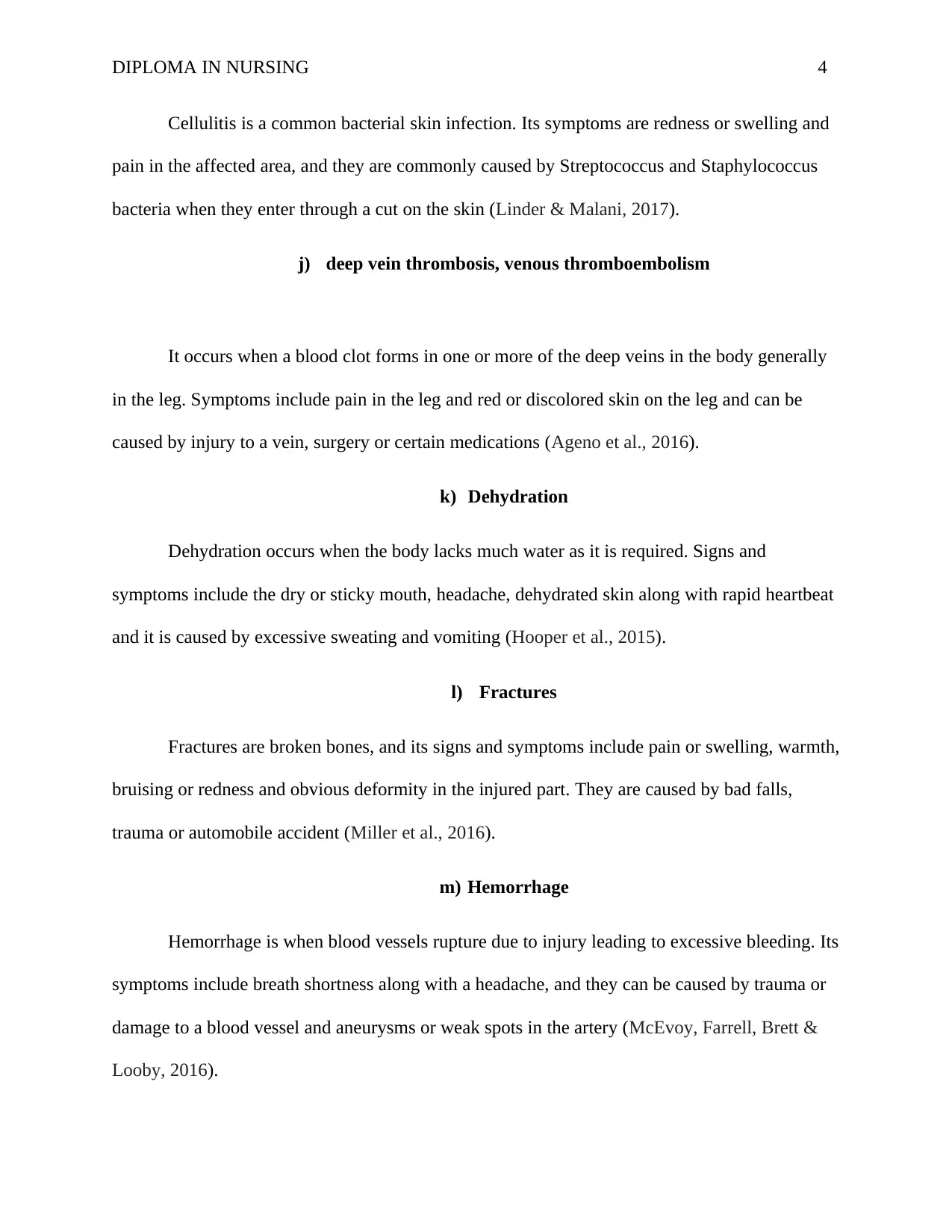
DIPLOMA IN NURSING 4
Cellulitis is a common bacterial skin infection. Its symptoms are redness or swelling and
pain in the affected area, and they are commonly caused by Streptococcus and Staphylococcus
bacteria when they enter through a cut on the skin (Linder & Malani, 2017).
j) deep vein thrombosis, venous thromboembolism
It occurs when a blood clot forms in one or more of the deep veins in the body generally
in the leg. Symptoms include pain in the leg and red or discolored skin on the leg and can be
caused by injury to a vein, surgery or certain medications (Ageno et al., 2016).
k) Dehydration
Dehydration occurs when the body lacks much water as it is required. Signs and
symptoms include the dry or sticky mouth, headache, dehydrated skin along with rapid heartbeat
and it is caused by excessive sweating and vomiting (Hooper et al., 2015).
l) Fractures
Fractures are broken bones, and its signs and symptoms include pain or swelling, warmth,
bruising or redness and obvious deformity in the injured part. They are caused by bad falls,
trauma or automobile accident (Miller et al., 2016).
m) Hemorrhage
Hemorrhage is when blood vessels rupture due to injury leading to excessive bleeding. Its
symptoms include breath shortness along with a headache, and they can be caused by trauma or
damage to a blood vessel and aneurysms or weak spots in the artery (McEvoy, Farrell, Brett &
Looby, 2016).
Cellulitis is a common bacterial skin infection. Its symptoms are redness or swelling and
pain in the affected area, and they are commonly caused by Streptococcus and Staphylococcus
bacteria when they enter through a cut on the skin (Linder & Malani, 2017).
j) deep vein thrombosis, venous thromboembolism
It occurs when a blood clot forms in one or more of the deep veins in the body generally
in the leg. Symptoms include pain in the leg and red or discolored skin on the leg and can be
caused by injury to a vein, surgery or certain medications (Ageno et al., 2016).
k) Dehydration
Dehydration occurs when the body lacks much water as it is required. Signs and
symptoms include the dry or sticky mouth, headache, dehydrated skin along with rapid heartbeat
and it is caused by excessive sweating and vomiting (Hooper et al., 2015).
l) Fractures
Fractures are broken bones, and its signs and symptoms include pain or swelling, warmth,
bruising or redness and obvious deformity in the injured part. They are caused by bad falls,
trauma or automobile accident (Miller et al., 2016).
m) Hemorrhage
Hemorrhage is when blood vessels rupture due to injury leading to excessive bleeding. Its
symptoms include breath shortness along with a headache, and they can be caused by trauma or
damage to a blood vessel and aneurysms or weak spots in the artery (McEvoy, Farrell, Brett &
Looby, 2016).
Paraphrase This Document
Need a fresh take? Get an instant paraphrase of this document with our AI Paraphraser
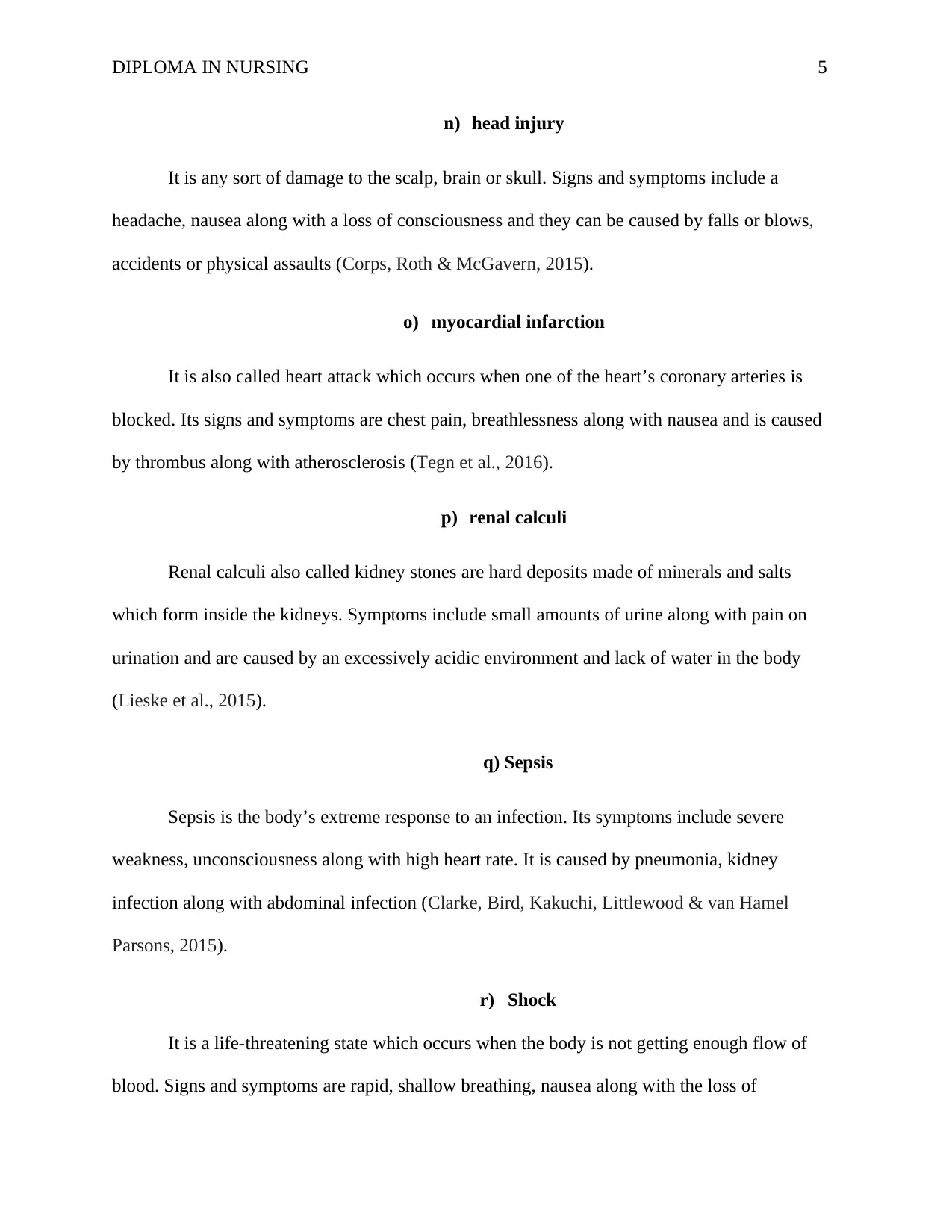
DIPLOMA IN NURSING 5
n) head injury
It is any sort of damage to the scalp, brain or skull. Signs and symptoms include a
headache, nausea along with a loss of consciousness and they can be caused by falls or blows,
accidents or physical assaults (Corps, Roth & McGavern, 2015).
o) myocardial infarction
It is also called heart attack which occurs when one of the heart’s coronary arteries is
blocked. Its signs and symptoms are chest pain, breathlessness along with nausea and is caused
by thrombus along with atherosclerosis (Tegn et al., 2016).
p) renal calculi
Renal calculi also called kidney stones are hard deposits made of minerals and salts
which form inside the kidneys. Symptoms include small amounts of urine along with pain on
urination and are caused by an excessively acidic environment and lack of water in the body
(Lieske et al., 2015).
q) Sepsis
Sepsis is the body’s extreme response to an infection. Its symptoms include severe
weakness, unconsciousness along with high heart rate. It is caused by pneumonia, kidney
infection along with abdominal infection (Clarke, Bird, Kakuchi, Littlewood & van Hamel
Parsons, 2015).
r) Shock
It is a life-threatening state which occurs when the body is not getting enough flow of
blood. Signs and symptoms are rapid, shallow breathing, nausea along with the loss of
n) head injury
It is any sort of damage to the scalp, brain or skull. Signs and symptoms include a
headache, nausea along with a loss of consciousness and they can be caused by falls or blows,
accidents or physical assaults (Corps, Roth & McGavern, 2015).
o) myocardial infarction
It is also called heart attack which occurs when one of the heart’s coronary arteries is
blocked. Its signs and symptoms are chest pain, breathlessness along with nausea and is caused
by thrombus along with atherosclerosis (Tegn et al., 2016).
p) renal calculi
Renal calculi also called kidney stones are hard deposits made of minerals and salts
which form inside the kidneys. Symptoms include small amounts of urine along with pain on
urination and are caused by an excessively acidic environment and lack of water in the body
(Lieske et al., 2015).
q) Sepsis
Sepsis is the body’s extreme response to an infection. Its symptoms include severe
weakness, unconsciousness along with high heart rate. It is caused by pneumonia, kidney
infection along with abdominal infection (Clarke, Bird, Kakuchi, Littlewood & van Hamel
Parsons, 2015).
r) Shock
It is a life-threatening state which occurs when the body is not getting enough flow of
blood. Signs and symptoms are rapid, shallow breathing, nausea along with the loss of
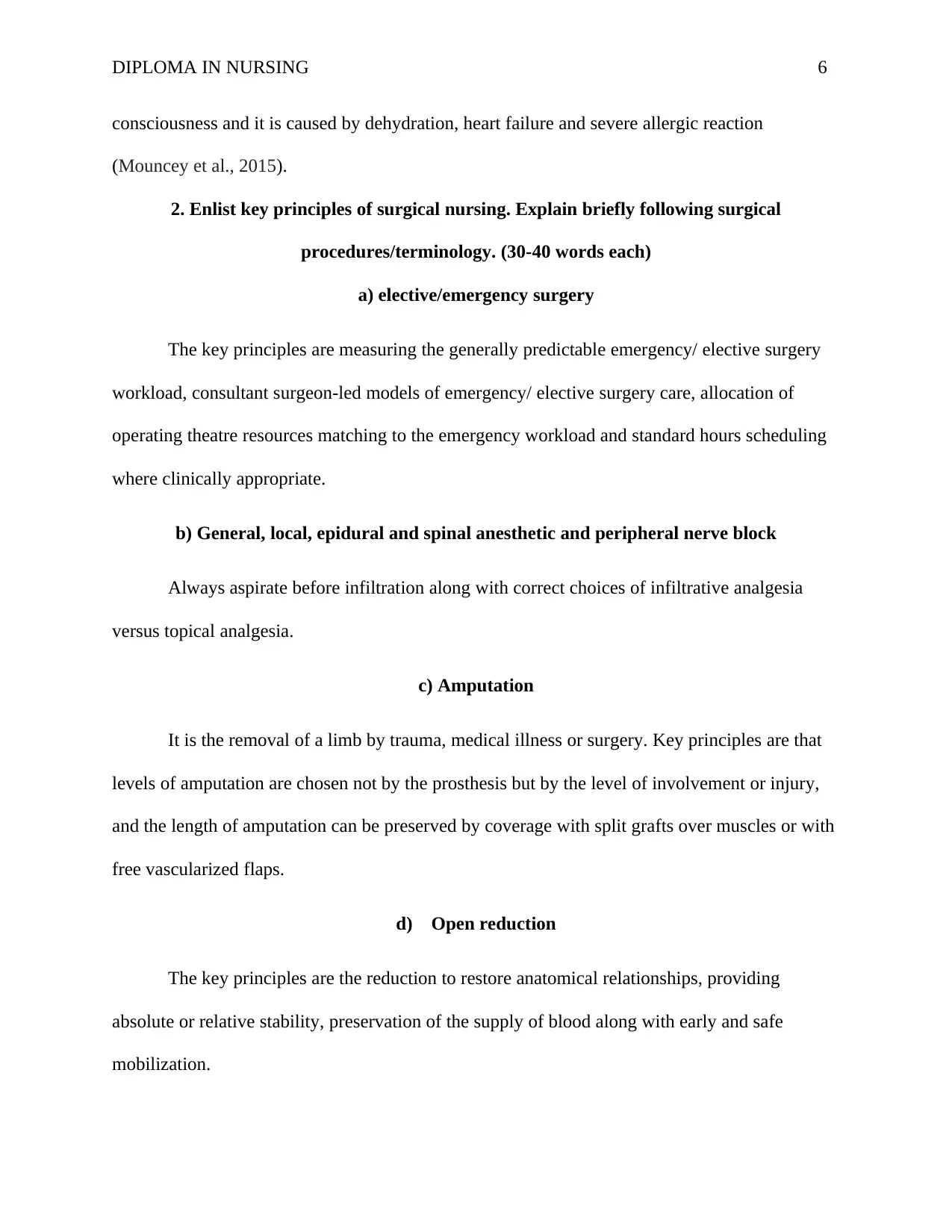
DIPLOMA IN NURSING 6
consciousness and it is caused by dehydration, heart failure and severe allergic reaction
(Mouncey et al., 2015).
2. Enlist key principles of surgical nursing. Explain briefly following surgical
procedures/terminology. (30-40 words each)
a) elective/emergency surgery
The key principles are measuring the generally predictable emergency/ elective surgery
workload, consultant surgeon-led models of emergency/ elective surgery care, allocation of
operating theatre resources matching to the emergency workload and standard hours scheduling
where clinically appropriate.
b) General, local, epidural and spinal anesthetic and peripheral nerve block
Always aspirate before infiltration along with correct choices of infiltrative analgesia
versus topical analgesia.
c) Amputation
It is the removal of a limb by trauma, medical illness or surgery. Key principles are that
levels of amputation are chosen not by the prosthesis but by the level of involvement or injury,
and the length of amputation can be preserved by coverage with split grafts over muscles or with
free vascularized flaps.
d) Open reduction
The key principles are the reduction to restore anatomical relationships, providing
absolute or relative stability, preservation of the supply of blood along with early and safe
mobilization.
consciousness and it is caused by dehydration, heart failure and severe allergic reaction
(Mouncey et al., 2015).
2. Enlist key principles of surgical nursing. Explain briefly following surgical
procedures/terminology. (30-40 words each)
a) elective/emergency surgery
The key principles are measuring the generally predictable emergency/ elective surgery
workload, consultant surgeon-led models of emergency/ elective surgery care, allocation of
operating theatre resources matching to the emergency workload and standard hours scheduling
where clinically appropriate.
b) General, local, epidural and spinal anesthetic and peripheral nerve block
Always aspirate before infiltration along with correct choices of infiltrative analgesia
versus topical analgesia.
c) Amputation
It is the removal of a limb by trauma, medical illness or surgery. Key principles are that
levels of amputation are chosen not by the prosthesis but by the level of involvement or injury,
and the length of amputation can be preserved by coverage with split grafts over muscles or with
free vascularized flaps.
d) Open reduction
The key principles are the reduction to restore anatomical relationships, providing
absolute or relative stability, preservation of the supply of blood along with early and safe
mobilization.
⊘ This is a preview!⊘
Do you want full access?
Subscribe today to unlock all pages.

Trusted by 1+ million students worldwide
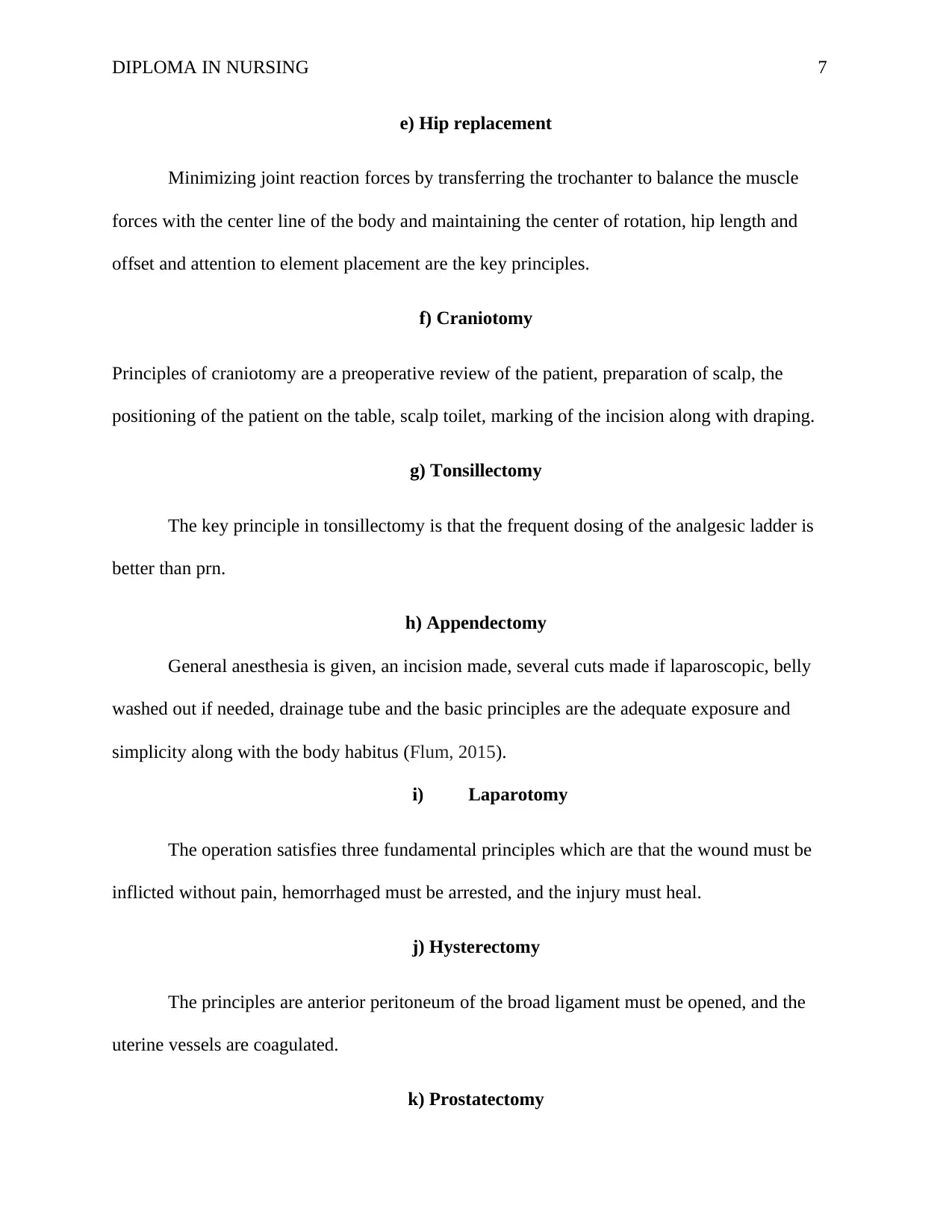
DIPLOMA IN NURSING 7
e) Hip replacement
Minimizing joint reaction forces by transferring the trochanter to balance the muscle
forces with the center line of the body and maintaining the center of rotation, hip length and
offset and attention to element placement are the key principles.
f) Craniotomy
Principles of craniotomy are a preoperative review of the patient, preparation of scalp, the
positioning of the patient on the table, scalp toilet, marking of the incision along with draping.
g) Tonsillectomy
The key principle in tonsillectomy is that the frequent dosing of the analgesic ladder is
better than prn.
h) Appendectomy
General anesthesia is given, an incision made, several cuts made if laparoscopic, belly
washed out if needed, drainage tube and the basic principles are the adequate exposure and
simplicity along with the body habitus (Flum, 2015).
i) Laparotomy
The operation satisfies three fundamental principles which are that the wound must be
inflicted without pain, hemorrhaged must be arrested, and the injury must heal.
j) Hysterectomy
The principles are anterior peritoneum of the broad ligament must be opened, and the
uterine vessels are coagulated.
k) Prostatectomy
e) Hip replacement
Minimizing joint reaction forces by transferring the trochanter to balance the muscle
forces with the center line of the body and maintaining the center of rotation, hip length and
offset and attention to element placement are the key principles.
f) Craniotomy
Principles of craniotomy are a preoperative review of the patient, preparation of scalp, the
positioning of the patient on the table, scalp toilet, marking of the incision along with draping.
g) Tonsillectomy
The key principle in tonsillectomy is that the frequent dosing of the analgesic ladder is
better than prn.
h) Appendectomy
General anesthesia is given, an incision made, several cuts made if laparoscopic, belly
washed out if needed, drainage tube and the basic principles are the adequate exposure and
simplicity along with the body habitus (Flum, 2015).
i) Laparotomy
The operation satisfies three fundamental principles which are that the wound must be
inflicted without pain, hemorrhaged must be arrested, and the injury must heal.
j) Hysterectomy
The principles are anterior peritoneum of the broad ligament must be opened, and the
uterine vessels are coagulated.
k) Prostatectomy
Paraphrase This Document
Need a fresh take? Get an instant paraphrase of this document with our AI Paraphraser
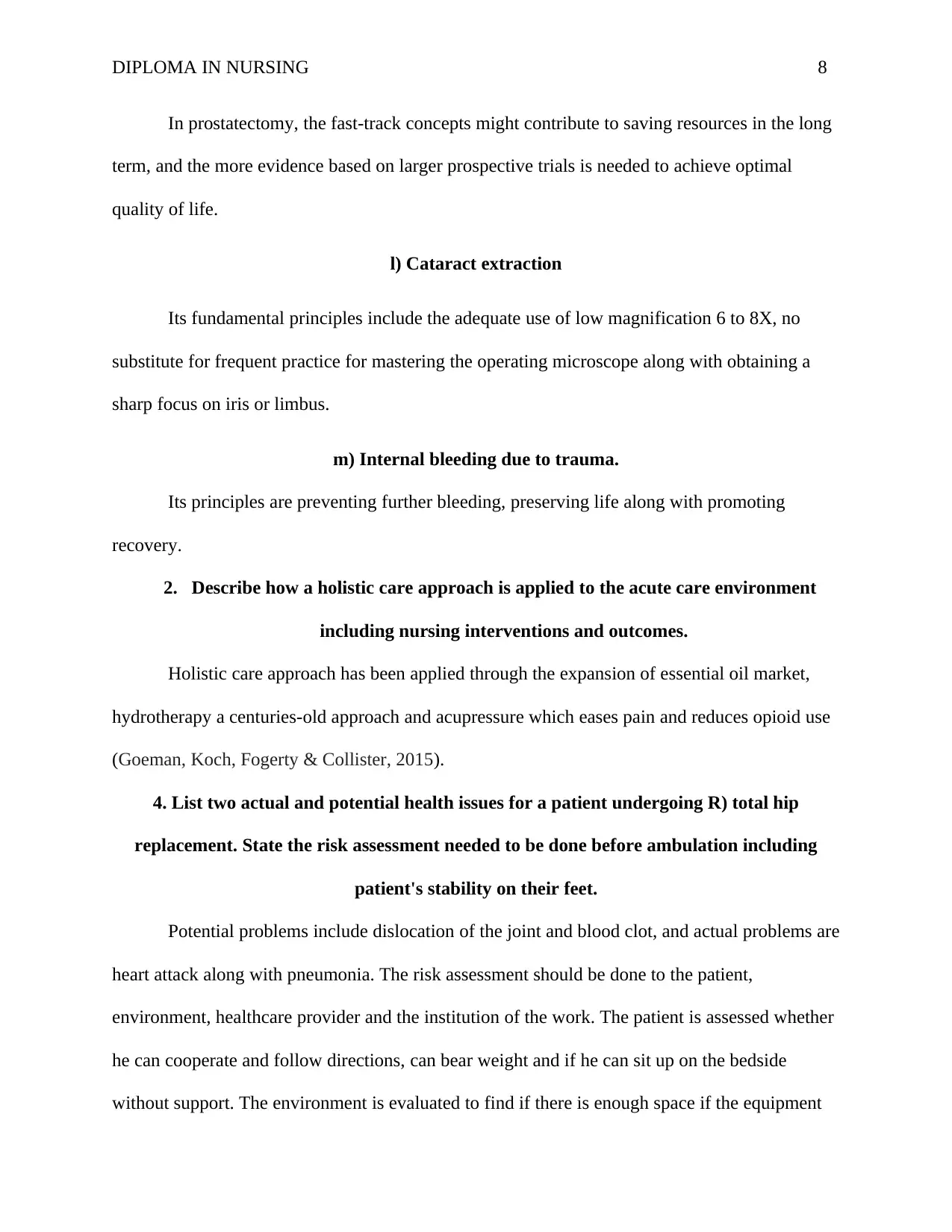
DIPLOMA IN NURSING 8
In prostatectomy, the fast-track concepts might contribute to saving resources in the long
term, and the more evidence based on larger prospective trials is needed to achieve optimal
quality of life.
l) Cataract extraction
Its fundamental principles include the adequate use of low magnification 6 to 8X, no
substitute for frequent practice for mastering the operating microscope along with obtaining a
sharp focus on iris or limbus.
m) Internal bleeding due to trauma.
Its principles are preventing further bleeding, preserving life along with promoting
recovery.
2. Describe how a holistic care approach is applied to the acute care environment
including nursing interventions and outcomes.
Holistic care approach has been applied through the expansion of essential oil market,
hydrotherapy a centuries-old approach and acupressure which eases pain and reduces opioid use
(Goeman, Koch, Fogerty & Collister, 2015).
4. List two actual and potential health issues for a patient undergoing R) total hip
replacement. State the risk assessment needed to be done before ambulation including
patient's stability on their feet.
Potential problems include dislocation of the joint and blood clot, and actual problems are
heart attack along with pneumonia. The risk assessment should be done to the patient,
environment, healthcare provider and the institution of the work. The patient is assessed whether
he can cooperate and follow directions, can bear weight and if he can sit up on the bedside
without support. The environment is evaluated to find if there is enough space if the equipment
In prostatectomy, the fast-track concepts might contribute to saving resources in the long
term, and the more evidence based on larger prospective trials is needed to achieve optimal
quality of life.
l) Cataract extraction
Its fundamental principles include the adequate use of low magnification 6 to 8X, no
substitute for frequent practice for mastering the operating microscope along with obtaining a
sharp focus on iris or limbus.
m) Internal bleeding due to trauma.
Its principles are preventing further bleeding, preserving life along with promoting
recovery.
2. Describe how a holistic care approach is applied to the acute care environment
including nursing interventions and outcomes.
Holistic care approach has been applied through the expansion of essential oil market,
hydrotherapy a centuries-old approach and acupressure which eases pain and reduces opioid use
(Goeman, Koch, Fogerty & Collister, 2015).
4. List two actual and potential health issues for a patient undergoing R) total hip
replacement. State the risk assessment needed to be done before ambulation including
patient's stability on their feet.
Potential problems include dislocation of the joint and blood clot, and actual problems are
heart attack along with pneumonia. The risk assessment should be done to the patient,
environment, healthcare provider and the institution of the work. The patient is assessed whether
he can cooperate and follow directions, can bear weight and if he can sit up on the bedside
without support. The environment is evaluated to find if there is enough space if the equipment
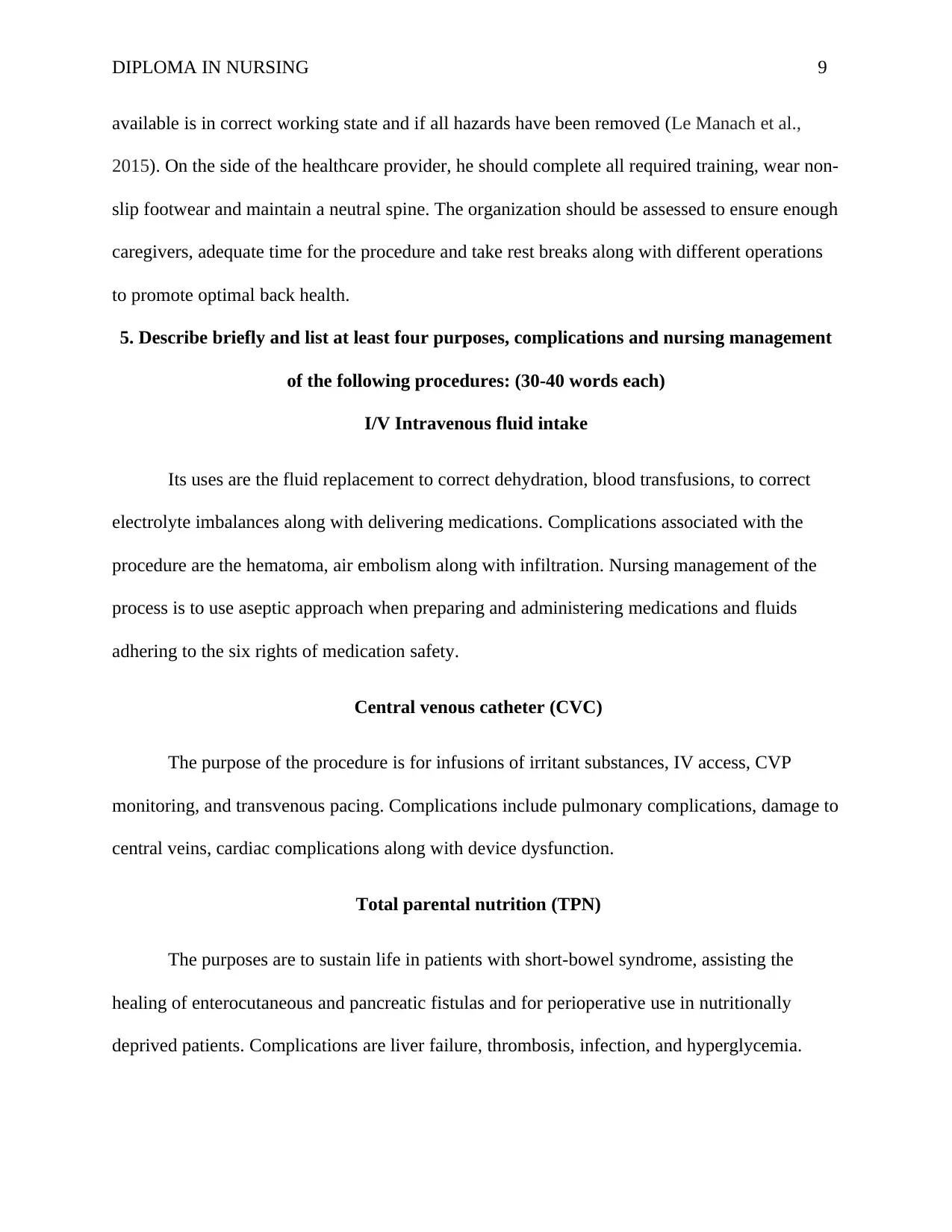
DIPLOMA IN NURSING 9
available is in correct working state and if all hazards have been removed (Le Manach et al.,
2015). On the side of the healthcare provider, he should complete all required training, wear non-
slip footwear and maintain a neutral spine. The organization should be assessed to ensure enough
caregivers, adequate time for the procedure and take rest breaks along with different operations
to promote optimal back health.
5. Describe briefly and list at least four purposes, complications and nursing management
of the following procedures: (30-40 words each)
I/V Intravenous fluid intake
Its uses are the fluid replacement to correct dehydration, blood transfusions, to correct
electrolyte imbalances along with delivering medications. Complications associated with the
procedure are the hematoma, air embolism along with infiltration. Nursing management of the
process is to use aseptic approach when preparing and administering medications and fluids
adhering to the six rights of medication safety.
Central venous catheter (CVC)
The purpose of the procedure is for infusions of irritant substances, IV access, CVP
monitoring, and transvenous pacing. Complications include pulmonary complications, damage to
central veins, cardiac complications along with device dysfunction.
Total parental nutrition (TPN)
The purposes are to sustain life in patients with short-bowel syndrome, assisting the
healing of enterocutaneous and pancreatic fistulas and for perioperative use in nutritionally
deprived patients. Complications are liver failure, thrombosis, infection, and hyperglycemia.
available is in correct working state and if all hazards have been removed (Le Manach et al.,
2015). On the side of the healthcare provider, he should complete all required training, wear non-
slip footwear and maintain a neutral spine. The organization should be assessed to ensure enough
caregivers, adequate time for the procedure and take rest breaks along with different operations
to promote optimal back health.
5. Describe briefly and list at least four purposes, complications and nursing management
of the following procedures: (30-40 words each)
I/V Intravenous fluid intake
Its uses are the fluid replacement to correct dehydration, blood transfusions, to correct
electrolyte imbalances along with delivering medications. Complications associated with the
procedure are the hematoma, air embolism along with infiltration. Nursing management of the
process is to use aseptic approach when preparing and administering medications and fluids
adhering to the six rights of medication safety.
Central venous catheter (CVC)
The purpose of the procedure is for infusions of irritant substances, IV access, CVP
monitoring, and transvenous pacing. Complications include pulmonary complications, damage to
central veins, cardiac complications along with device dysfunction.
Total parental nutrition (TPN)
The purposes are to sustain life in patients with short-bowel syndrome, assisting the
healing of enterocutaneous and pancreatic fistulas and for perioperative use in nutritionally
deprived patients. Complications are liver failure, thrombosis, infection, and hyperglycemia.
⊘ This is a preview!⊘
Do you want full access?
Subscribe today to unlock all pages.

Trusted by 1+ million students worldwide
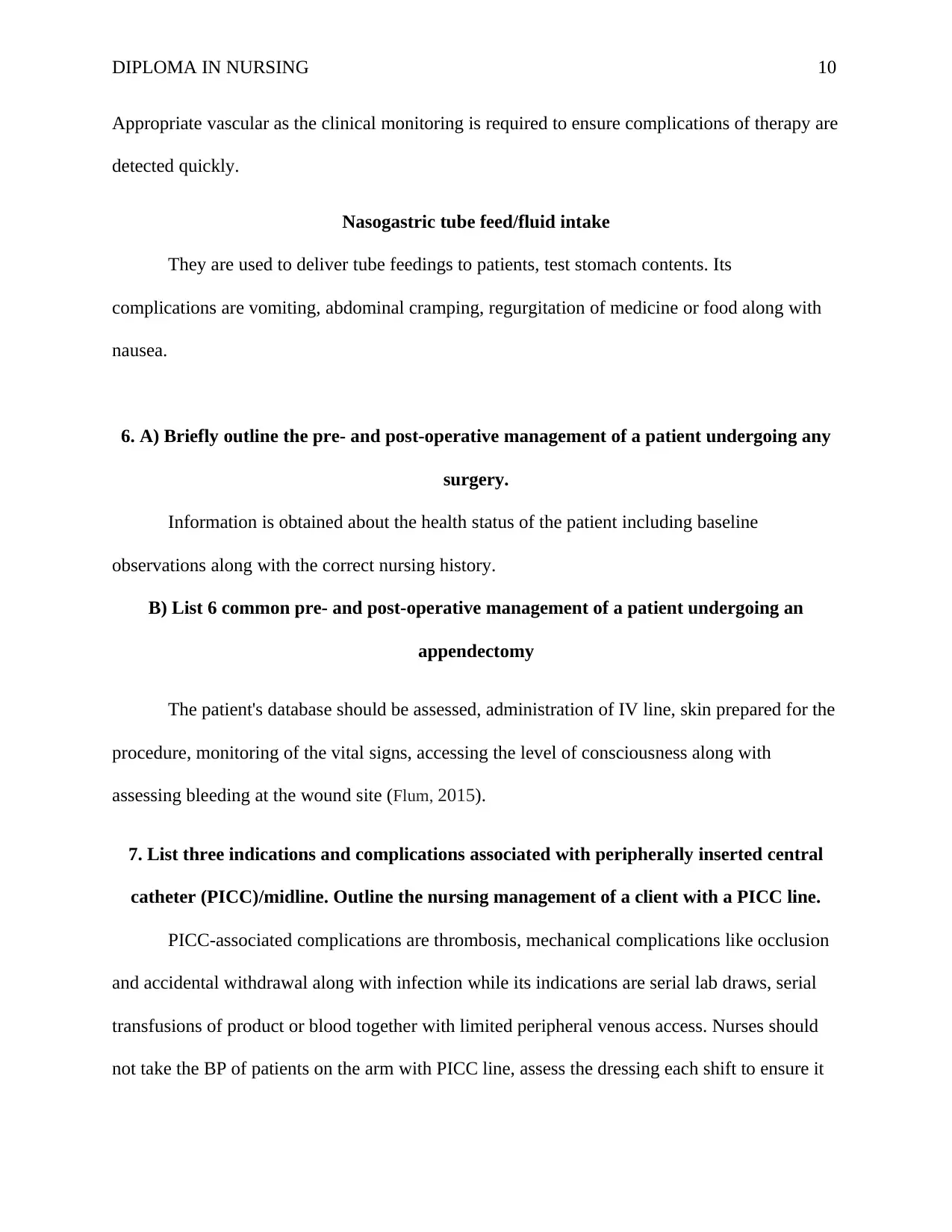
DIPLOMA IN NURSING 10
Appropriate vascular as the clinical monitoring is required to ensure complications of therapy are
detected quickly.
Nasogastric tube feed/fluid intake
They are used to deliver tube feedings to patients, test stomach contents. Its
complications are vomiting, abdominal cramping, regurgitation of medicine or food along with
nausea.
6. A) Briefly outline the pre- and post-operative management of a patient undergoing any
surgery.
Information is obtained about the health status of the patient including baseline
observations along with the correct nursing history.
B) List 6 common pre- and post-operative management of a patient undergoing an
appendectomy
The patient's database should be assessed, administration of IV line, skin prepared for the
procedure, monitoring of the vital signs, accessing the level of consciousness along with
assessing bleeding at the wound site (Flum, 2015).
7. List three indications and complications associated with peripherally inserted central
catheter (PICC)/midline. Outline the nursing management of a client with a PICC line.
PICC-associated complications are thrombosis, mechanical complications like occlusion
and accidental withdrawal along with infection while its indications are serial lab draws, serial
transfusions of product or blood together with limited peripheral venous access. Nurses should
not take the BP of patients on the arm with PICC line, assess the dressing each shift to ensure it
Appropriate vascular as the clinical monitoring is required to ensure complications of therapy are
detected quickly.
Nasogastric tube feed/fluid intake
They are used to deliver tube feedings to patients, test stomach contents. Its
complications are vomiting, abdominal cramping, regurgitation of medicine or food along with
nausea.
6. A) Briefly outline the pre- and post-operative management of a patient undergoing any
surgery.
Information is obtained about the health status of the patient including baseline
observations along with the correct nursing history.
B) List 6 common pre- and post-operative management of a patient undergoing an
appendectomy
The patient's database should be assessed, administration of IV line, skin prepared for the
procedure, monitoring of the vital signs, accessing the level of consciousness along with
assessing bleeding at the wound site (Flum, 2015).
7. List three indications and complications associated with peripherally inserted central
catheter (PICC)/midline. Outline the nursing management of a client with a PICC line.
PICC-associated complications are thrombosis, mechanical complications like occlusion
and accidental withdrawal along with infection while its indications are serial lab draws, serial
transfusions of product or blood together with limited peripheral venous access. Nurses should
not take the BP of patients on the arm with PICC line, assess the dressing each shift to ensure it
Paraphrase This Document
Need a fresh take? Get an instant paraphrase of this document with our AI Paraphraser
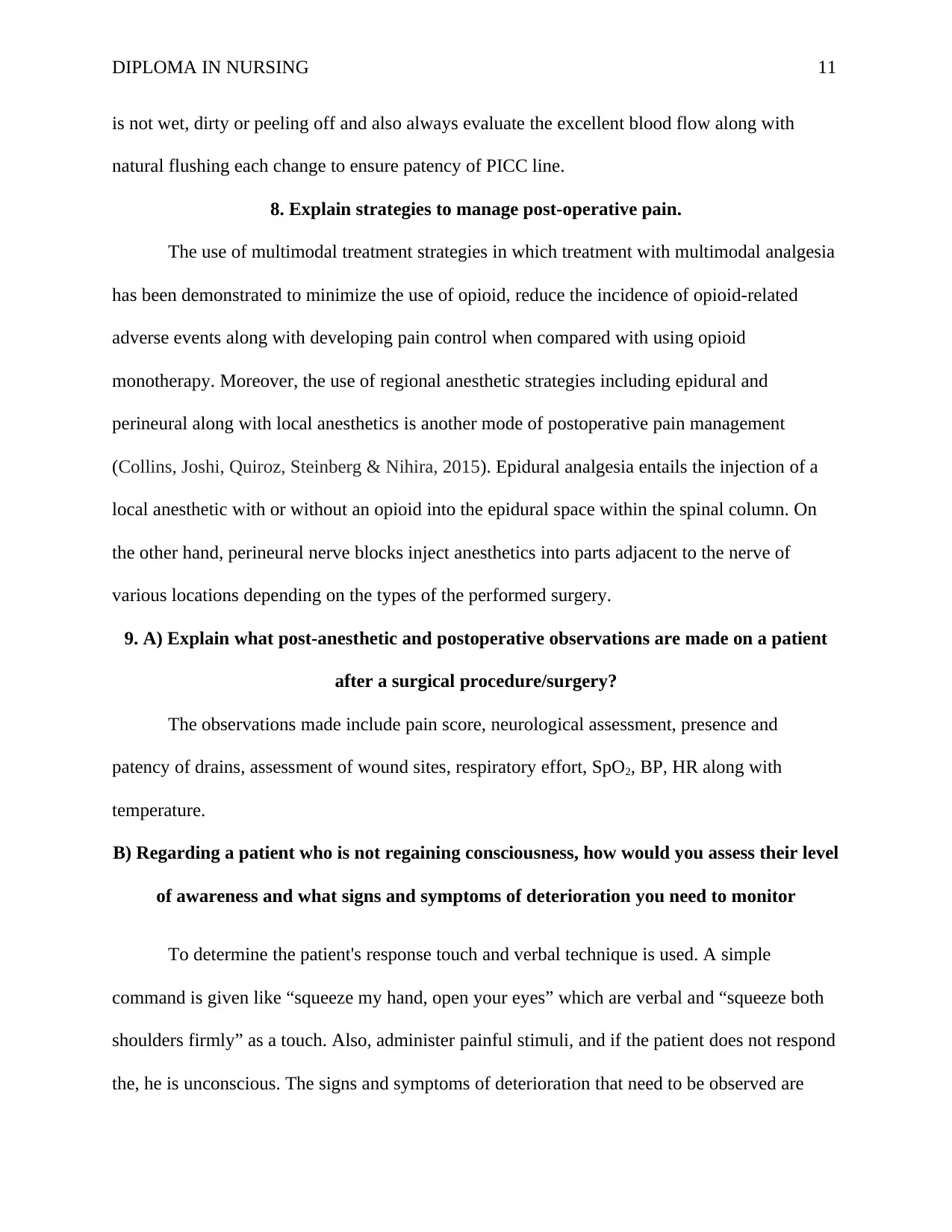
DIPLOMA IN NURSING 11
is not wet, dirty or peeling off and also always evaluate the excellent blood flow along with
natural flushing each change to ensure patency of PICC line.
8. Explain strategies to manage post-operative pain.
The use of multimodal treatment strategies in which treatment with multimodal analgesia
has been demonstrated to minimize the use of opioid, reduce the incidence of opioid-related
adverse events along with developing pain control when compared with using opioid
monotherapy. Moreover, the use of regional anesthetic strategies including epidural and
perineural along with local anesthetics is another mode of postoperative pain management
(Collins, Joshi, Quiroz, Steinberg & Nihira, 2015). Epidural analgesia entails the injection of a
local anesthetic with or without an opioid into the epidural space within the spinal column. On
the other hand, perineural nerve blocks inject anesthetics into parts adjacent to the nerve of
various locations depending on the types of the performed surgery.
9. A) Explain what post-anesthetic and postoperative observations are made on a patient
after a surgical procedure/surgery?
The observations made include pain score, neurological assessment, presence and
patency of drains, assessment of wound sites, respiratory effort, SpO2, BP, HR along with
temperature.
B) Regarding a patient who is not regaining consciousness, how would you assess their level
of awareness and what signs and symptoms of deterioration you need to monitor
To determine the patient's response touch and verbal technique is used. A simple
command is given like “squeeze my hand, open your eyes” which are verbal and “squeeze both
shoulders firmly” as a touch. Also, administer painful stimuli, and if the patient does not respond
the, he is unconscious. The signs and symptoms of deterioration that need to be observed are
is not wet, dirty or peeling off and also always evaluate the excellent blood flow along with
natural flushing each change to ensure patency of PICC line.
8. Explain strategies to manage post-operative pain.
The use of multimodal treatment strategies in which treatment with multimodal analgesia
has been demonstrated to minimize the use of opioid, reduce the incidence of opioid-related
adverse events along with developing pain control when compared with using opioid
monotherapy. Moreover, the use of regional anesthetic strategies including epidural and
perineural along with local anesthetics is another mode of postoperative pain management
(Collins, Joshi, Quiroz, Steinberg & Nihira, 2015). Epidural analgesia entails the injection of a
local anesthetic with or without an opioid into the epidural space within the spinal column. On
the other hand, perineural nerve blocks inject anesthetics into parts adjacent to the nerve of
various locations depending on the types of the performed surgery.
9. A) Explain what post-anesthetic and postoperative observations are made on a patient
after a surgical procedure/surgery?
The observations made include pain score, neurological assessment, presence and
patency of drains, assessment of wound sites, respiratory effort, SpO2, BP, HR along with
temperature.
B) Regarding a patient who is not regaining consciousness, how would you assess their level
of awareness and what signs and symptoms of deterioration you need to monitor
To determine the patient's response touch and verbal technique is used. A simple
command is given like “squeeze my hand, open your eyes” which are verbal and “squeeze both
shoulders firmly” as a touch. Also, administer painful stimuli, and if the patient does not respond
the, he is unconscious. The signs and symptoms of deterioration that need to be observed are
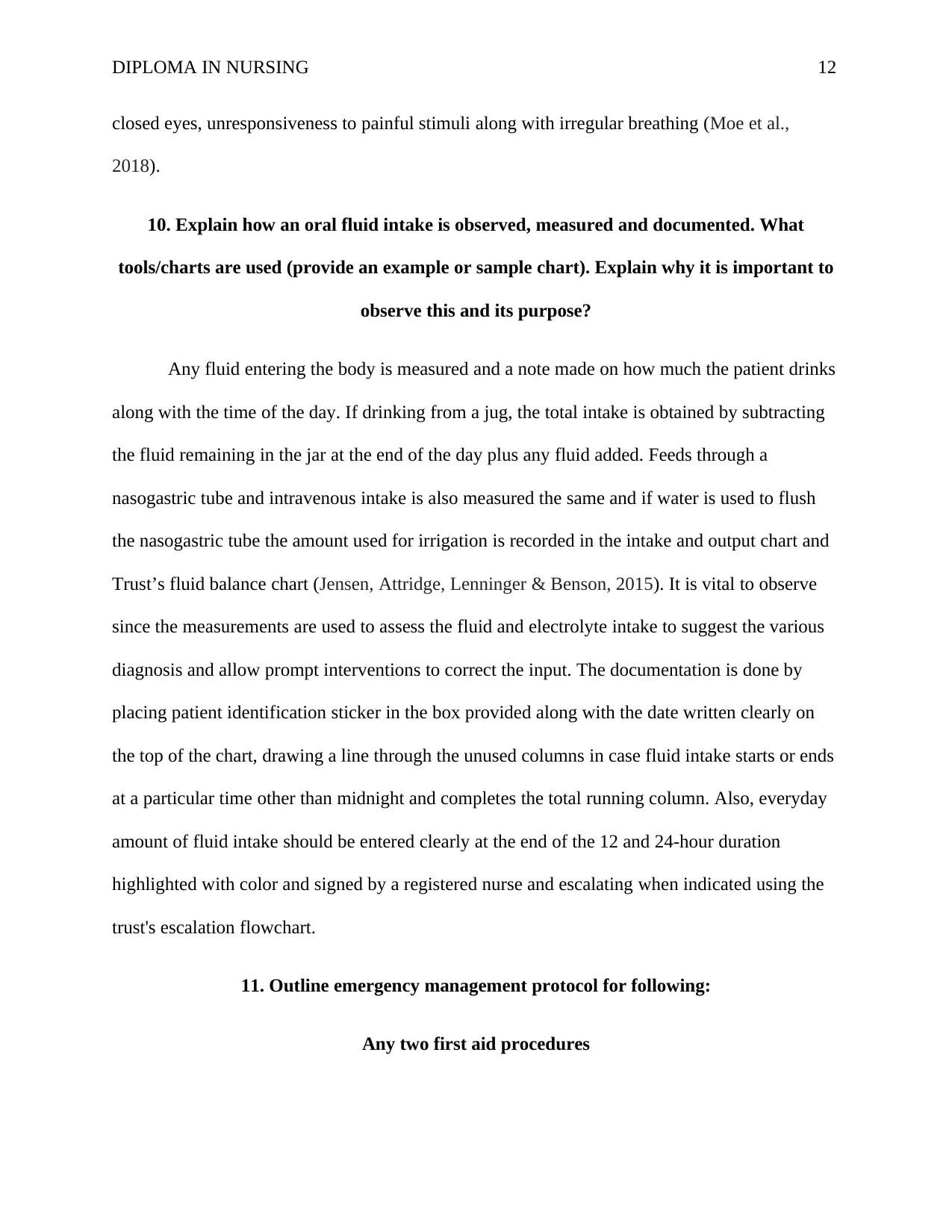
DIPLOMA IN NURSING 12
closed eyes, unresponsiveness to painful stimuli along with irregular breathing (Moe et al.,
2018).
10. Explain how an oral fluid intake is observed, measured and documented. What
tools/charts are used (provide an example or sample chart). Explain why it is important to
observe this and its purpose?
Any fluid entering the body is measured and a note made on how much the patient drinks
along with the time of the day. If drinking from a jug, the total intake is obtained by subtracting
the fluid remaining in the jar at the end of the day plus any fluid added. Feeds through a
nasogastric tube and intravenous intake is also measured the same and if water is used to flush
the nasogastric tube the amount used for irrigation is recorded in the intake and output chart and
Trust’s fluid balance chart (Jensen, Attridge, Lenninger & Benson, 2015). It is vital to observe
since the measurements are used to assess the fluid and electrolyte intake to suggest the various
diagnosis and allow prompt interventions to correct the input. The documentation is done by
placing patient identification sticker in the box provided along with the date written clearly on
the top of the chart, drawing a line through the unused columns in case fluid intake starts or ends
at a particular time other than midnight and completes the total running column. Also, everyday
amount of fluid intake should be entered clearly at the end of the 12 and 24-hour duration
highlighted with color and signed by a registered nurse and escalating when indicated using the
trust's escalation flowchart.
11. Outline emergency management protocol for following:
Any two first aid procedures
closed eyes, unresponsiveness to painful stimuli along with irregular breathing (Moe et al.,
2018).
10. Explain how an oral fluid intake is observed, measured and documented. What
tools/charts are used (provide an example or sample chart). Explain why it is important to
observe this and its purpose?
Any fluid entering the body is measured and a note made on how much the patient drinks
along with the time of the day. If drinking from a jug, the total intake is obtained by subtracting
the fluid remaining in the jar at the end of the day plus any fluid added. Feeds through a
nasogastric tube and intravenous intake is also measured the same and if water is used to flush
the nasogastric tube the amount used for irrigation is recorded in the intake and output chart and
Trust’s fluid balance chart (Jensen, Attridge, Lenninger & Benson, 2015). It is vital to observe
since the measurements are used to assess the fluid and electrolyte intake to suggest the various
diagnosis and allow prompt interventions to correct the input. The documentation is done by
placing patient identification sticker in the box provided along with the date written clearly on
the top of the chart, drawing a line through the unused columns in case fluid intake starts or ends
at a particular time other than midnight and completes the total running column. Also, everyday
amount of fluid intake should be entered clearly at the end of the 12 and 24-hour duration
highlighted with color and signed by a registered nurse and escalating when indicated using the
trust's escalation flowchart.
11. Outline emergency management protocol for following:
Any two first aid procedures
⊘ This is a preview!⊘
Do you want full access?
Subscribe today to unlock all pages.

Trusted by 1+ million students worldwide
1 out of 26
Related Documents
Your All-in-One AI-Powered Toolkit for Academic Success.
+13062052269
info@desklib.com
Available 24*7 on WhatsApp / Email
![[object Object]](/_next/static/media/star-bottom.7253800d.svg)
Unlock your academic potential
Copyright © 2020–2025 A2Z Services. All Rights Reserved. Developed and managed by ZUCOL.





